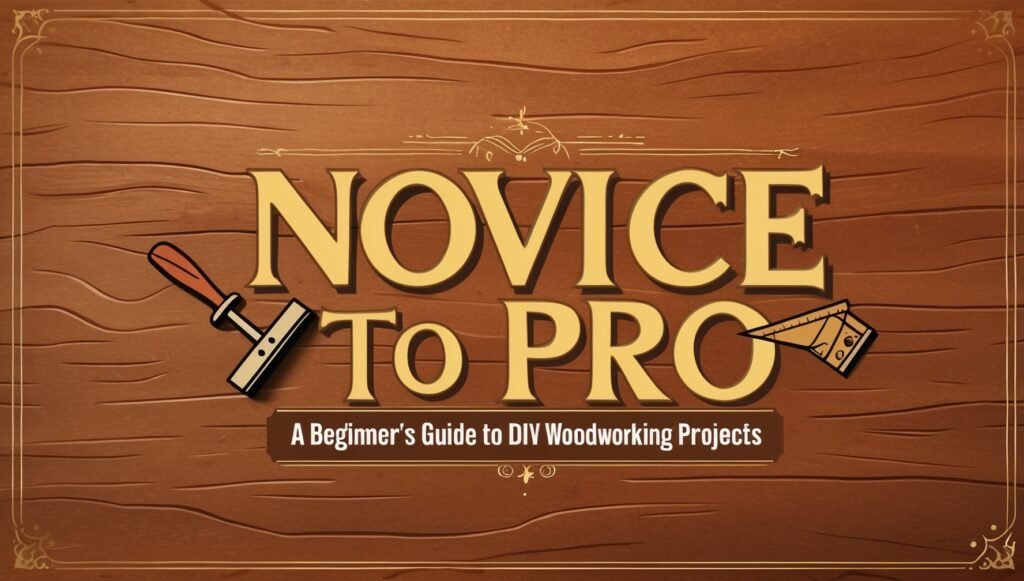
Hey, lovely ladies! If you’ve ever looked at a piece of furniture, a beautiful wooden shelf, or even a well-crafted wooden box and thought, “Wow, I’d love to make something like that,” you’re not alone. When I first thought about getting into woodworking, I felt a little intimidated, but over time, I learned that with the right mindset and a bit of guidance, I could create my own masterpieces. And guess what? So can you!
Woodworking might seem like something only experts can do, but it’s totally accessible to us beginners. With the right tools, patience, and a willingness to learn, you can go from a novice to a pro in no time. So let’s roll up our sleeves and get into the exciting world of DIY woodworking!

Why Woodworking is Perfect for Women Like Us
When I first started woodworking, I was hesitant. I wondered if I could handle the tools, if I’d mess up, or if I was “allowed” to be in a space that’s often considered male-dominated. But here’s what I learned: woodworking isn’t about gender. It’s about creativity, problem-solving, and creating something beautiful with your own hands. And if that doesn’t scream empowerment, I don’t know what does!
Woodworking is all about learning new skills and gaining confidence with every project. It’s also incredibly therapeutic. You’re working with your hands, focused on the task, and the sense of accomplishment when you see your finished piece is indescribable. Whether it’s crafting a rustic coffee table or building a bookshelf to organize your favorite books, woodworking lets you create pieces that are both functional and stylish.
If you’re feeling nervous about starting, I totally get it. I was there once, too. But remember, every pro started out as a beginner. And like any other skill, the more you practice, the better you’ll get. Trust me, you’ve got this.
Step 1: Start Small and Build Confidence
When starting out in woodworking, it’s important to begin with minor projects. Think of them as the building blocks that will help you develop your skills and gain the confidence you need to take on larger, more complex projects. Here are a few beginner-friendly ideas:
Wooden Coasters: Perfect for practicing cuts and sanding. You can complete these minor projects in an afternoon.
Picture Frames: A simple way to get familiar with angles and working with wood glue.
Shelves: Installing floating shelves is a great way to practice measuring and drilling.
The key is to pick a project that isn’t overwhelming but still allows you to learn the basics of woodworking. This way, you’ll get a proper sense of accomplishment, and it’ll motivate you to keep going.
One project I absolutely loved starting with was making a simple bookshelf. It was small, easy to do, and provided such a practical use. Plus, it helped me understand how to measure, cut, and assemble wood—skills that are essential for larger projects down the line.

Step 2: Gather the Right Tools
Having the right tools can make all the difference in your woodworking experience. Now, I’m not suggesting you rush out and buy a whole workshop of equipment (unless you want to, of course!), but there are some essentials you’ll need to get started. Here’s a basic list:
Measuring Tape and Square: You can’t cut wood accurately if you don’t measure it properly. A measuring tape and a square are your best friends here.
Saw (Hand or Power): A basic hand saw works just fine for minor projects, but as you advance, a power saw will make life a lot easier.
Wood Glue: The key to holding things together while you wait for the wood to set.
Sander or Sandpaper: Smooth surfaces are essential for a polished finish.
Hammer and Nails: These are staples for most woodworking projects.
Once you have these basics, you’ll be well on your way to starting your woodworking journey. Don’t be afraid to invest in quality tools, as they make the job easier and more enjoyable.
Pro Tip: Don’t feel you have to buy everything at once! Start with the basics and build your collection as you go along. You can even find great second-hand tools for a fraction of the cost.
Step 3: Learn Basic Techniques
Before diving into more advanced projects, it’s important to get comfortable with the core woodworking techniques. These are the skills you’ll use in almost every project, so mastering them will set you up for success. Some essential techniques include:
Measuring and Cutting: Get comfortable with accurate measurements and cutting wood to size. The more precise you are, the better your finished project will look.
Sanding: Learn how to sand wood evenly to create a smooth surface. This is a crucial step that many beginners skip, but it’s key to a professional-looking finish.
Assembling: Knowing how to properly glue, screw, or nail pieces of wood together is essential for creating sturdy furniture.
As you gain confidence in these basic skills, you can start experimenting with more advanced techniques, like staining, carving, or building complex structures.
Step 4: Get Creative and Challenge Yourself
Once you’ve mastered the basics, it’s time to challenge yourself and get creative! Try building more complex projects, like a dining table or a coffee table. These projects will allow you to combine everything you’ve learned while offering a great sense of accomplishment when they’re done.
One of my favorite storybooks related to this idea is Hands That Speak—it’s about a woman who channels her energy and creativity into woodworking after facing a tough situation. It shows how powerful and transformative crafting can be. I highly recommend it for inspiration!
The beauty of woodworking is that it’s both practical and artistic. Whether you’re crafting something functional like a storage unit or adding a decorative touch to your home, woodworking allows you to express yourself in ways that are both creative and useful.
Step 5: Don’t Forget About Safety
I want to emphasize the importance of safety when working with wood and tools. Always wear safety glasses and a dust mask when cutting or sanding wood. Work in a well-ventilated area, and keep your workspace organized. It’s better to take your time and be safe than rush and risk injury.

You Can Do It!
So, ladies, if you’ve been thinking about trying your hand at woodworking, now is the perfect time to start. It’s all about taking that first step, no matter how small the project may seem. Start with something simple, gather your tools, and focus on the basics. Then, let your creativity flow and challenge yourself to try bigger projects as you go along.
Just remember, every expert started as a beginner, and I promise you that you’re more than capable of turning your DIY woodworking dreams into reality.
For even more inspiration, check out She Can Fix Anything—Even a Broken Heart—another fantastic story of a woman learning to take control of her life and her DIY skills!
So, let’s get out there and start building, ladies. We’ve got this!
FixItSmartly.com helps everyday people save money and build confidence by tackling home and car repairs with easy, practical DIY solutions. Live smart, safe, and self-reliant — one fix at a time.
Copyright © 2025 Fixitsmartly